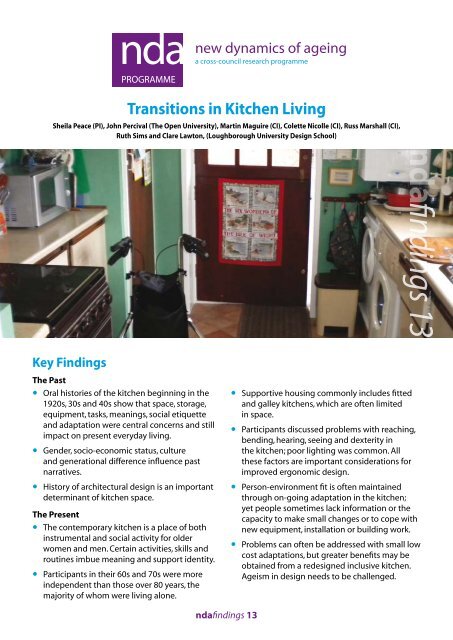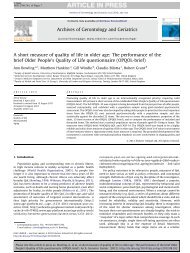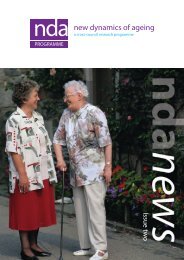Transitions in Kitchen Living - New Dynamics of Ageing - University ...
Transitions in Kitchen Living - New Dynamics of Ageing - University ...
Transitions in Kitchen Living - New Dynamics of Ageing - University ...
Create successful ePaper yourself
Turn your PDF publications into a flip-book with our unique Google optimized e-Paper software.
new dynamics <strong>of</strong> age<strong>in</strong>g<br />
a cross-council research programme<br />
<strong>Transitions</strong> <strong>in</strong> <strong>Kitchen</strong> Liv<strong>in</strong>g<br />
Sheila Peace (PI), John Percival (The Open <strong>University</strong>), Mart<strong>in</strong> Maguire (CI), Colette Nicolle (CI), Russ Marshall (CI),<br />
Ruth Sims and Clare Lawton, (Loughborough <strong>University</strong> Design School)<br />
ndaf<strong>in</strong>d<strong>in</strong>gs 13<br />
Key F<strong>in</strong>d<strong>in</strong>gs<br />
The Past<br />
• Oral histories <strong>of</strong> the kitchen beg<strong>in</strong>n<strong>in</strong>g <strong>in</strong> the<br />
1920s, 30s and 40s show that space, storage,<br />
equipment, tasks, mean<strong>in</strong>gs, social etiquette<br />
and adaptation were central concerns and still<br />
impact on present everyday liv<strong>in</strong>g.<br />
•<br />
Gender, socio-economic status, culture<br />
and generational difference <strong>in</strong>fluence past<br />
narratives.<br />
•<br />
History <strong>of</strong> architectural design is an important<br />
determ<strong>in</strong>ant <strong>of</strong> kitchen space.<br />
The Present<br />
• The contemporary kitchen is a place <strong>of</strong> both<br />
<strong>in</strong>strumental and social activity for older<br />
women and men. Certa<strong>in</strong> activities, skills and<br />
rout<strong>in</strong>es imbue mean<strong>in</strong>g and support identity.<br />
•<br />
Participants <strong>in</strong> their 60s and 70s were more<br />
<strong>in</strong>dependent than those over 80 years, the<br />
majority <strong>of</strong> whom were liv<strong>in</strong>g alone.<br />
• Supportive hous<strong>in</strong>g commonly <strong>in</strong>cludes fitted<br />
and galley kitchens, which are <strong>of</strong>ten limited<br />
<strong>in</strong> space.<br />
•<br />
Participants discussed problems with reach<strong>in</strong>g,<br />
bend<strong>in</strong>g, hear<strong>in</strong>g, see<strong>in</strong>g and dexterity <strong>in</strong><br />
the kitchen; poor light<strong>in</strong>g was common. All<br />
these factors are important considerations for<br />
improved ergonomic design.<br />
•<br />
Person-environment fit is <strong>of</strong>ten ma<strong>in</strong>ta<strong>in</strong>ed<br />
through on-go<strong>in</strong>g adaptation <strong>in</strong> the kitchen;<br />
yet people sometimes lack <strong>in</strong>formation or the<br />
capacity to make small changes or to cope with<br />
new equipment, <strong>in</strong>stallation or build<strong>in</strong>g work.<br />
•<br />
Problems can <strong>of</strong>ten be addressed with small low<br />
cost adaptations, but greater benefits may be<br />
obta<strong>in</strong>ed from a redesigned <strong>in</strong>clusive kitchen.<br />
Ageism <strong>in</strong> design needs to be challenged.<br />
ndaf<strong>in</strong>d<strong>in</strong>gs 13
Some th<strong>in</strong>gs are too far<br />
The Future<br />
• Research test<strong>in</strong>g older people’s attitudes to<br />
kitchen technology shows that at present<br />
issues relat<strong>in</strong>g to personal safety are more<br />
important than facilitat<strong>in</strong>g everyday activity<br />
as health changes.<br />
•<br />
<strong>New</strong> technologies such as motorised<br />
worktops, automatic appliance shut <strong>of</strong>f,<br />
small pr<strong>in</strong>t readers on packag<strong>in</strong>g and, more<br />
Some th<strong>in</strong>gs are too high<br />
futuristically, smart fridges that report shopp<strong>in</strong>g<br />
needs and place orders could facilitate current<br />
cop<strong>in</strong>g skills.<br />
•<br />
•<br />
Lack <strong>of</strong> awareness <strong>of</strong> technical possibilities and<br />
doubts about their feasibility were apparent.<br />
Key issues raised have implications for ways<br />
<strong>of</strong> th<strong>in</strong>k<strong>in</strong>g about theories <strong>of</strong> environment<br />
and age<strong>in</strong>g.<br />
2<br />
Background<br />
For people <strong>of</strong> all ages the kitchen can be the hub<br />
<strong>of</strong> the home and a centre <strong>of</strong> person-environment<br />
<strong>in</strong>teraction. Researchers from many discipl<strong>in</strong>es have<br />
studied both <strong>in</strong>stitutional and domestic kitchens:<br />
Social scientists are concerned with cultural history;<br />
the gendered nature <strong>of</strong> domestic space; the rout<strong>in</strong>es<br />
and rituals associated with everyday activities, and the<br />
com<strong>in</strong>g <strong>of</strong> technologies. Biologists and food scientists<br />
are <strong>in</strong>terested <strong>in</strong> dietary and eat<strong>in</strong>g practices, hygiene<br />
and nutritional state. Architects, designers and<br />
ergonomists are concerned with the design, spatial<br />
configuration and efficiency <strong>of</strong> functional space.<br />
Yet what do we know <strong>of</strong> older people’s experience<br />
<strong>of</strong> the kitchen? Previous evidence has been limited.<br />
For the <strong>New</strong> <strong>Dynamics</strong> <strong>of</strong> Age<strong>in</strong>g programme, the<br />
kitchen provides a laboratory for focus<strong>in</strong>g on age<strong>in</strong>g<br />
with<strong>in</strong> the built environment and how autonomy<br />
and <strong>in</strong>dependence are enabled or disabled through<br />
personal history, current health and well-be<strong>in</strong>g, and<br />
design and technological <strong>in</strong>tervention. Exam<strong>in</strong>ation<br />
<strong>of</strong> these issues can lead to outputs which have<br />
practical value to older people themselves, as well<br />
as family members, designers, practitioners and the<br />
wider retail sector.<br />
ndaf<strong>in</strong>d<strong>in</strong>gs 13<br />
Aim and objectives<br />
The lack <strong>of</strong> <strong>in</strong>tegrated multi-discipl<strong>in</strong>ary research<br />
concern<strong>in</strong>g kitchen liv<strong>in</strong>g <strong>in</strong> later life forms the<br />
rationale for this project. The overall aim was to<br />
<strong>in</strong>vestigate the experience <strong>of</strong> the kitchen for people<br />
currently <strong>in</strong> their 60s, 70s, 80s and 90s liv<strong>in</strong>g <strong>in</strong> a<br />
variety <strong>of</strong> ma<strong>in</strong>stream and supportive 1 hous<strong>in</strong>g <strong>in</strong><br />
England. The project had a number <strong>of</strong> objectives to:<br />
• Provide historical and contemporary<br />
understand<strong>in</strong>gs <strong>of</strong> the material, social and<br />
psychological aspects <strong>of</strong> kitchen experience<br />
guided by life events and exam<strong>in</strong><strong>in</strong>g role, function<br />
and design.<br />
• Consider person-environment fit through the<br />
juxtaposition <strong>of</strong> <strong>in</strong>dividual health and wellbe<strong>in</strong>g,<br />
practical aspects <strong>of</strong> kitchen liv<strong>in</strong>g and the<br />
potential for improv<strong>in</strong>g the kitchen to meet older<br />
people’s needs.<br />
• Extend theoretical development <strong>in</strong> environmental<br />
gerontology through a focus on kitchen liv<strong>in</strong>g.<br />
1<br />
‘Ma<strong>in</strong>stream’ hous<strong>in</strong>g <strong>in</strong>cluded all types: detached, semi-detached, terraced, maisonettes,<br />
bungalows, high and low rise flats; Supportive hous<strong>in</strong>g <strong>in</strong>cluded: sheltered hous<strong>in</strong>g, extracare<br />
hous<strong>in</strong>g and retirement hous<strong>in</strong>g and apartments. In supportive accommodation<br />
participants had their own kitchen but could eat communally if they wished. Care homes<br />
were not <strong>in</strong>cluded as meals are usually taken communally.
• Develop methodological systems for triangulation<br />
<strong>of</strong> data that are historical and contemporary;<br />
<strong>in</strong>dividual and contextual; qualitative and<br />
quantitative.<br />
•<br />
Develop an archivable resource <strong>of</strong> research data<br />
<strong>of</strong> value to the lay public, practitioners, kitchen<br />
designers and academics that contributes to an<br />
understand<strong>in</strong>g <strong>of</strong> user requirements for <strong>in</strong>clusive<br />
kitchen design or adaptation.<br />
Approach and Method<br />
The research was both collaborative and<br />
multidiscipl<strong>in</strong>ary, <strong>in</strong>volv<strong>in</strong>g social gerontologists<br />
from the Faculty <strong>of</strong> Health and Social Care at The<br />
Open <strong>University</strong> and ergonomists at Loughborough<br />
<strong>University</strong>’s Design School. By sett<strong>in</strong>g out to<br />
research experiences <strong>of</strong> past and present kitchens,<br />
detailed pilot work was undertaken <strong>in</strong>volv<strong>in</strong>g five<br />
older people rang<strong>in</strong>g <strong>in</strong> age, gender, ethnicity and<br />
accommodation to develop a comprehensive mixed<br />
methods approach.<br />
In the ma<strong>in</strong> study two <strong>in</strong>terviews were held with each<br />
<strong>of</strong> the 48 participants dur<strong>in</strong>g 2009-10 alongside other<br />
data collection. The first <strong>in</strong>terview gathered an oral<br />
history <strong>of</strong> kitchens experienced across the life course,<br />
<strong>in</strong>formed by a hous<strong>in</strong>g history record and a life event<br />
guide, e.g. first remembered home, parental home<br />
when a teenager, <strong>in</strong>dependent liv<strong>in</strong>g.<br />
The second semi-structured <strong>in</strong>terview focused on the<br />
present kitchen, how well it met the person’s abilities<br />
and needs and any cop<strong>in</strong>g strategies they adopted.<br />
It conta<strong>in</strong>ed both multiple choice and open-ended<br />
questions. The <strong>in</strong>terview also considered the person’s<br />
health and well-be<strong>in</strong>g as well as their activities.<br />
It covered aspects such as physical abilities (mobility<br />
and dexterity), sight, hear<strong>in</strong>g etc., whether the person<br />
cooks, what they like to eat and then discussion about<br />
difficulties complet<strong>in</strong>g various tasks such as cook<strong>in</strong>g,<br />
wash<strong>in</strong>g, iron<strong>in</strong>g, recycl<strong>in</strong>g and feed<strong>in</strong>g pets. Prior to<br />
this meet<strong>in</strong>g self-completion records <strong>of</strong> rout<strong>in</strong>e<br />
kitchen activities and basic demographic <strong>in</strong>formation<br />
were collected.<br />
Sketches were made <strong>of</strong> the kitchen layout;<br />
photographs taken <strong>of</strong> <strong>in</strong>terest<strong>in</strong>g features,<br />
solutions, compromises, and problems as directed<br />
by participants and measurements recorded to<br />
calculate the kitchen ‘work triangle’ 2 and kitchen<br />
area. Measurements were also taken <strong>of</strong> the height <strong>of</strong><br />
2<br />
The kitchen ‘work triangle’ and kitchen area used <strong>in</strong> ergonomic teach<strong>in</strong>g considers<br />
movement between the kitchen s<strong>in</strong>k, cooker and refrigerator. This is now seen to be<br />
a more complex pathway.<br />
ndaf<strong>in</strong>d<strong>in</strong>gs 13<br />
the lowest cupboard shelf to consider accessibility.<br />
Light level measurements were taken <strong>in</strong> three<br />
particular locations: at the kitchen s<strong>in</strong>k, where food<br />
was prepared and where food was eaten, e.g. at<br />
the kitchen table (where appropriate). These were<br />
recorded both with the kitchen lights on and <strong>of</strong>f.<br />
Full ethical approval was sought and ga<strong>in</strong>ed<br />
from both <strong>in</strong>stitutions prior to the research be<strong>in</strong>g<br />
undertaken. The team had several face-to-face<br />
meet<strong>in</strong>gs to plan the study, share skills and to<br />
conduct pilot<strong>in</strong>g, e.g. a gerontologist lead<strong>in</strong>g a pilot<br />
oral history <strong>in</strong>terview with an ergonomist observ<strong>in</strong>g,<br />
and then revers<strong>in</strong>g the roles for the current kitchen<br />
<strong>in</strong>terview. Research analysis was undertaken<br />
collectively.<br />
Participants<br />
The research <strong>in</strong>volved a purposive sample <strong>of</strong> 48<br />
people liv<strong>in</strong>g <strong>in</strong> urban and semi-rural areas <strong>of</strong> Bristol<br />
and Loughborough. The participants were chosen<br />
to meet specific criteria based on age, hous<strong>in</strong>g type<br />
and gender. The age range was deliberately chosen<br />
to <strong>in</strong>clude people <strong>in</strong> their 60s through to their 90s to<br />
encompass the sociological categorizations <strong>of</strong> the<br />
‘third ‘ and ‘fourth’ ages and to consider the impact <strong>of</strong><br />
age on design issues. The participants were recruited<br />
across three age groups, 60–69, 70-79, and 80+,<br />
with 16 people <strong>in</strong> each group. There were 31 female<br />
participants and 17 males see (Table 1), reflect<strong>in</strong>g the<br />
gender ratio <strong>in</strong> later life. Dates <strong>of</strong> birth for the whole<br />
sample ranged from 1919 to 1948.<br />
Table 1: Age and gender <strong>of</strong> sample (N=48)<br />
Age group Men Women TOTAL<br />
60–69 years 10 6 16<br />
70–79 years 4 12 16<br />
80–91 years 3 13 16<br />
TOTAL 17 31 48<br />
The ethnicity pr<strong>of</strong>ile <strong>of</strong> the participants was 46<br />
‘White British’ and two ‘Asian or British Asian’. Of<br />
the 48 participants, five were couples, each be<strong>in</strong>g<br />
<strong>in</strong>terviewed separately thus the total number <strong>of</strong><br />
properties <strong>in</strong> the sample was 43. These <strong>in</strong>cluded<br />
14 detached or semi-detached, n<strong>in</strong>e bungalows,<br />
seven terraced houses or town houses and 13<br />
apartments, six <strong>of</strong> which were sheltered or extracare<br />
accommodation. Information was also gathered<br />
about education, <strong>in</strong>come, ethnic background and who<br />
else lived <strong>in</strong> the household. This ensured a range <strong>of</strong><br />
3
people from different backgrounds and <strong>in</strong> different<br />
contexts. Regard<strong>in</strong>g others <strong>in</strong> the household, 27<br />
participants lived on their own while 21 lived with a<br />
spouse or partner. Of the 41 who provided household<br />
<strong>in</strong>come <strong>in</strong>formation, 30 had a total <strong>in</strong>come <strong>of</strong> less than<br />
£20,000 while 11 had an <strong>in</strong>come <strong>of</strong> £20,000 or more.<br />
F<strong>in</strong>d<strong>in</strong>gs<br />
“What will come out over and over<br />
aga<strong>in</strong> from me is that what we had <strong>in</strong> those days<br />
was a kitchen , a back kitchen or sometimes called<br />
a scullery and a walk-<strong>in</strong> larder and a walk-<strong>in</strong> coal<br />
shed, a yard and with this sort <strong>of</strong> house a brick<br />
built wash house. So <strong>in</strong> what you would call<br />
the kitchen, the biggest <strong>of</strong> the lot, had a brick<br />
stove on the adjo<strong>in</strong><strong>in</strong>g wall.”<br />
Childhood reflections from the late 1920s<br />
(female, aged 88 years)<br />
The Past <strong>Kitchen</strong><br />
Each person <strong>in</strong>volved <strong>in</strong> the study was asked to<br />
relate their ‘kitchen history’ and comment on the<br />
kitchens they had experienced throughout their life.<br />
This <strong>in</strong>formation was analysed and key themes were<br />
identified concern<strong>in</strong>g space, equipment/utilities,<br />
tasks, storage, social etiquette, mean<strong>in</strong>g/identity, and<br />
changes made.<br />
The narratives display the gendered use <strong>of</strong> kitchen<br />
space over time. In England, the childhood homes<br />
that many <strong>of</strong> today’s older people grew up <strong>in</strong>,<br />
predated central heat<strong>in</strong>g. Typically the kitchen was<br />
the warmest room <strong>in</strong> the house due to coal-fired<br />
heat<strong>in</strong>g. Participants <strong>of</strong> all ages reported on the<br />
kitchen as a place where family members would talk,<br />
read, listen to the radio, mend clothes, make jam, do<br />
homework, play board games, eat meals and do the<br />
laundry. For the oldest participants, allied spaces,<br />
such as the scullery, were highly valued ‘back kitchen’<br />
areas with a Belfast or Butler s<strong>in</strong>k, where laundry<br />
equipment such as the copper, the wash board and<br />
the mangle might be stored and used, or where food<br />
preparation or even bath<strong>in</strong>g might take place. The<br />
larder was a valuable cool walk-<strong>in</strong> space.<br />
<strong>Kitchen</strong>s <strong>in</strong> which today’s older people raised<br />
their families tended to be sparsely furnished and<br />
equipped, <strong>in</strong>itially, but as <strong>in</strong>come and family size grew,<br />
new appliances were bought and valued, especially<br />
those that were labour-sav<strong>in</strong>g, cost-effective, and <strong>of</strong><br />
a modern design. The kitchen was commonly the<br />
woman’s doma<strong>in</strong>, but men helped by fitt<strong>in</strong>g work<br />
surfaces and tiles, mak<strong>in</strong>g tables, and <strong>in</strong> pre and post<br />
World War Two, provid<strong>in</strong>g home grown or allotment<br />
produce for eat<strong>in</strong>g or preserv<strong>in</strong>g. Over time, social<br />
etiquette concern<strong>in</strong>g where and how people ate their<br />
meals changed. This was reflected <strong>in</strong> comments on<br />
the kitchen hatch to the d<strong>in</strong><strong>in</strong>g room; the hostess<br />
trolley; the through room and the different location <strong>of</strong><br />
weekday and weekend meals.<br />
The kitchen rema<strong>in</strong>s an important hub with<strong>in</strong> older<br />
people’s homes, a multi-functional space where<br />
‘everyth<strong>in</strong>g happens’, <strong>in</strong>clud<strong>in</strong>g bak<strong>in</strong>g, writ<strong>in</strong>g letters,<br />
feed<strong>in</strong>g pets and hav<strong>in</strong>g tea with a friend. Older<br />
people <strong>of</strong>ten f<strong>in</strong>d it personally reward<strong>in</strong>g to cont<strong>in</strong>ue<br />
with familiar kitchen rout<strong>in</strong>es and skills known all<br />
their lives.<br />
The Current <strong>Kitchen</strong><br />
Discussion <strong>of</strong> the current kitchen focused on carry<strong>in</strong>g<br />
out and manag<strong>in</strong>g everyday activities <strong>in</strong> relation to<br />
the kitchen layout, design and equipment. The 48<br />
research participants had a range <strong>of</strong> physical abilities:<br />
17 hav<strong>in</strong>g some sight problems and 13 with hear<strong>in</strong>g<br />
problems. Access and movement was also a significant<br />
issue with 26 participants experienc<strong>in</strong>g reach<strong>in</strong>g<br />
problems <strong>in</strong> the kitchen and 19 report<strong>in</strong>g dexterity<br />
problems such as when us<strong>in</strong>g kitchen implements.<br />
Health problems <strong>in</strong>creased with age. N<strong>in</strong>e people<br />
used mobility aids while one person was a female<br />
wheelchair user aged 61, <strong>in</strong>dicat<strong>in</strong>g the importance<br />
<strong>of</strong> <strong>in</strong>clusive design solutions to kitchen issues.<br />
4 ndaf<strong>in</strong>d<strong>in</strong>gs 13<br />
The carousel helps
Adaptations are not always convenient<br />
Common Problems and<br />
Suggestions<br />
The most common problems reported were read<strong>in</strong>g<br />
small <strong>in</strong>structions on packaged food or other<br />
kitchen products and see<strong>in</strong>g the cooker controls.<br />
Bright sun also made oven or microwave controls<br />
hard to read. Some people put on glasses but this<br />
could be a hazard if lean<strong>in</strong>g over a hot oven plate.<br />
Measurement <strong>of</strong> light<strong>in</strong>g levels found that the<br />
food preparation areas were the most poorly lit,<br />
both naturally and artificially, fall<strong>in</strong>g well below<br />
recommended m<strong>in</strong>imum levels. Despite the use <strong>of</strong><br />
hear<strong>in</strong>g aids by some, several people experienced<br />
problems such as hear<strong>in</strong>g the door bell or the phone<br />
r<strong>in</strong>g with the kettle on, as well as the ceil<strong>in</strong>g light<br />
humm<strong>in</strong>g caus<strong>in</strong>g distraction. Cop<strong>in</strong>g strategies<br />
<strong>in</strong>cluded simply not leav<strong>in</strong>g th<strong>in</strong>gs unsupervised <strong>in</strong><br />
the kitchen or when mov<strong>in</strong>g to another room leav<strong>in</strong>g<br />
the kitchen door open.<br />
To address problems <strong>of</strong> reach<strong>in</strong>g or stretch<strong>in</strong>g to<br />
use appliances or access cupboards, participants<br />
coped by crouch<strong>in</strong>g rather than bend<strong>in</strong>g down, us<strong>in</strong>g<br />
steps to get to higher shelves, and pull<strong>in</strong>g themselves<br />
up us<strong>in</strong>g the worktop. Arguably steps could pose a<br />
certa<strong>in</strong> risk for some older users although they tried<br />
to m<strong>in</strong>imise this by careful usage. Some participants<br />
had a carousel shelf <strong>in</strong>stalled to avoid hav<strong>in</strong>g to reach<br />
<strong>in</strong>to a cupboard or to more easily access several items<br />
located together such as jars, herb and spice bottles.<br />
(See photo on p. 4). One participant had new wall<br />
cupboards located at a level lower than standard<br />
which made the higher shelves more accessible.<br />
The fitted gallery kitchen had advantages and disadvantages<br />
Many people owned special gadgets for open<strong>in</strong>g<br />
jars, cans and milk cartons to overcome limitations<br />
<strong>of</strong> dexterity, movement and strength, caused<br />
by pa<strong>in</strong>ful arthritis. Less support was apparent for<br />
tasks such as lift<strong>in</strong>g a heavy pan or dish, or turn<strong>in</strong>g<br />
a difficult knob or tap. Although several people<br />
received help from others with shopp<strong>in</strong>g, many did<br />
it themselves, sometimes us<strong>in</strong>g mobility aids such as<br />
a stick or scooter. No one stated that they shopped<br />
onl<strong>in</strong>e. Physical disability was the ma<strong>in</strong> barrier to<br />
prepar<strong>in</strong>g food, e.g. pa<strong>in</strong> and lack <strong>of</strong> strength when<br />
peel<strong>in</strong>g and chopp<strong>in</strong>g, backache when stand<strong>in</strong>g for<br />
bak<strong>in</strong>g, etc. Sitt<strong>in</strong>g for food preparation (requir<strong>in</strong>g<br />
a lower work surface) and tak<strong>in</strong>g rest breaks were<br />
useful strategies. Space for a kitchen table was not<br />
always available so eat<strong>in</strong>g, especially when liv<strong>in</strong>g<br />
alone, would take place <strong>in</strong> a liv<strong>in</strong>g or d<strong>in</strong><strong>in</strong>g room<br />
<strong>of</strong>ten with a TV or radio for company.<br />
A number <strong>of</strong> cop<strong>in</strong>g strategies for wash<strong>in</strong>g up<br />
were suggested such as: <strong>in</strong>stall<strong>in</strong>g a sliml<strong>in</strong>e or<br />
counter-top dishwasher and us<strong>in</strong>g it frequently;<br />
load<strong>in</strong>g dishwasher utensils as they were used and<br />
hand wash<strong>in</strong>g them if not very dirty. Sometimes a<br />
kettle was seen as heavy and unsafe to lift. Some<br />
used a small lightweight kettle or a microwave for<br />
heat<strong>in</strong>g water. It was also commented that adequate<br />
light and colour contrast for crockery, surfaces<br />
and surface edges was needed for those with<br />
impaired vision.<br />
For the people who owned a microwave, problems<br />
<strong>in</strong>cluded: it be<strong>in</strong>g located at the wrong height,<br />
the door be<strong>in</strong>g on the wrong side, light fall<strong>in</strong>g<br />
on the display, cook<strong>in</strong>g the food for too long, and<br />
transport<strong>in</strong>g food from the microwave, when hot, to<br />
the table or work surface. The simple operation <strong>of</strong><br />
a microwave was seen as important but not always<br />
delivered. An oven/microwave comb<strong>in</strong>ation was also<br />
found useful and convenient.<br />
ndaf<strong>in</strong>d<strong>in</strong>gs 13<br />
5
Space savers<br />
When wash<strong>in</strong>g and dry<strong>in</strong>g clothes open<strong>in</strong>g the<br />
appliance door was sometimes problematic. One<br />
person experienced difficulty carry<strong>in</strong>g the clothes<br />
outside so shuffled the wash basket with her feet.<br />
General strategies for manag<strong>in</strong>g the household<br />
wash<strong>in</strong>g and dry<strong>in</strong>g <strong>in</strong>cluded us<strong>in</strong>g radiators or a<br />
clothes horse, dry<strong>in</strong>g <strong>in</strong> a warm area such as the<br />
conservatory, wash<strong>in</strong>g small amounts at a time, and<br />
do<strong>in</strong>g it <strong>in</strong> the afternoon and dry<strong>in</strong>g with heaters<br />
overnight. Some people <strong>in</strong> sheltered accommodation<br />
had a shared laundry facility while one couple used a<br />
commercial laundry.<br />
Iron<strong>in</strong>g was the most commonly reported task<br />
caus<strong>in</strong>g problems with iron<strong>in</strong>g boards be<strong>in</strong>g heavy to<br />
carry and hard to open. Strategies adopted to make<br />
iron<strong>in</strong>g easier were to only use the iron<strong>in</strong>g board for<br />
large items, hav<strong>in</strong>g clothes that did not need much<br />
iron<strong>in</strong>g, and not iron<strong>in</strong>g underwear and sheets.<br />
<strong>Kitchen</strong> clean<strong>in</strong>g problems <strong>in</strong>cluded gett<strong>in</strong>g an<br />
appliance out to clean beh<strong>in</strong>d it, bend<strong>in</strong>g to clean the<br />
oven and fridge, clean<strong>in</strong>g from a wheelchair, reach<strong>in</strong>g<br />
to clean the w<strong>in</strong>dows and vacuum<strong>in</strong>g the kitchen<br />
carpet. Everyone did recycl<strong>in</strong>g. Most had a waste b<strong>in</strong><br />
<strong>in</strong> the kitchen and many had a designated space or<br />
conta<strong>in</strong>ers for items to recycle. Problems <strong>in</strong>cluded<br />
bend<strong>in</strong>g to empty the pedal b<strong>in</strong> and know<strong>in</strong>g which<br />
bags to put different items <strong>of</strong> waste or recycl<strong>in</strong>g <strong>in</strong>to.<br />
One person <strong>of</strong>ten found their shared b<strong>in</strong> compound<br />
locked, and gett<strong>in</strong>g recycl<strong>in</strong>g to the pavement or<br />
roadside b<strong>in</strong> could be a problem.<br />
People were asked what changes they had made or<br />
would like to make <strong>in</strong> their kitchen. These <strong>in</strong>cluded:<br />
•<br />
Appliances: more plug sockets or better height<br />
and position<strong>in</strong>g, dishwasher, automatic kettle,<br />
lighter iron and pull out board, water filter tap<br />
and lever taps.<br />
Helpful bi-fold doors<br />
• Environment: a light that can be lowered over the<br />
table, light<strong>in</strong>g over/under cupboards, a mirror over<br />
the s<strong>in</strong>k to see the garden (the kitchen w<strong>in</strong>dow<br />
was too high to see out), better light<strong>in</strong>g <strong>in</strong> larger<br />
or walk-<strong>in</strong> cupboards and space for a table.<br />
•<br />
Clean<strong>in</strong>g: a lighter floor to show dirt, v<strong>in</strong>yl <strong>of</strong>f-cuts<br />
on top <strong>of</strong> wall units so they can be removed and<br />
cleaned, a ‘truly self-clean<strong>in</strong>g oven’.<br />
•<br />
Reach<strong>in</strong>g and access: shallower drawers, pull<br />
out shelves <strong>in</strong> cupboards, corner cupboards with<br />
revolv<strong>in</strong>g units for access.<br />
The future kitchen<br />
The TiKL project has enabled us to th<strong>in</strong>k about<br />
problems that older people face <strong>in</strong> the kitchen and to<br />
identify simple and practical solutions to overcome<br />
them <strong>in</strong>clud<strong>in</strong>g more advanced technology to make<br />
kitchen life easier. Many <strong>of</strong> these ideas are based on<br />
the ‘ambient kitchen’ where <strong>in</strong>tegrated technologies<br />
provide subtle but effective support to meet people’s<br />
needs whether physical or cognitive.<br />
A survey was conducted with a further group <strong>of</strong> older<br />
people to obta<strong>in</strong> their reactions to some <strong>of</strong> the ideas<br />
and concepts beh<strong>in</strong>d the smart or ‘techno kitchen’.<br />
The 45 respondents <strong>in</strong>cluded 30 females and 15<br />
males, aged from 60 to over 90 years.<br />
Questions consisted <strong>of</strong> a list <strong>of</strong> possible technological<br />
enhancements or <strong>in</strong>novations that might help<br />
someone <strong>in</strong> the kitchen. Respondents were asked to<br />
state whether they would like to have each one <strong>in</strong><br />
their own kitchen or not.<br />
6 ndaf<strong>in</strong>d<strong>in</strong>gs 13
A selection <strong>of</strong> the <strong>in</strong>novations are shown <strong>in</strong> order <strong>of</strong><br />
<strong>in</strong>creas<strong>in</strong>g popularity, together with the percentage<br />
<strong>of</strong> people want<strong>in</strong>g each one:<br />
• Auditory or visual read out <strong>of</strong> fridge contents to<br />
save look<strong>in</strong>g <strong>in</strong>side and wast<strong>in</strong>g energy when<br />
open<strong>in</strong>g the door – 36%<br />
• A device to scan and read out small text on<br />
packag<strong>in</strong>g – 50%<br />
• Ability to raise or lower cupboard height for easier<br />
access – 56%<br />
• Ability to raise or lower worktop or s<strong>in</strong>k height for<br />
easier or seated use – 58%<br />
• Task light that comes on automatically when<br />
needed – 69%<br />
Remote control <strong>of</strong> w<strong>in</strong>dows and bl<strong>in</strong>ds – 69%<br />
Quick cool<strong>in</strong>g oven hob – 73%<br />
Possible flood alert warn<strong>in</strong>g – 81%<br />
• Automatic turn <strong>of</strong>f <strong>of</strong> electrical appliances<br />
e.g. iron, toaster or oven when the person<br />
leaves the house – 91%<br />
The results show that there is enthusiasm for certa<strong>in</strong><br />
types <strong>of</strong> technological support <strong>in</strong> the kitchen. Most<br />
<strong>in</strong>terest was expressed <strong>in</strong> technology that <strong>in</strong>creases<br />
safety <strong>in</strong> the kitchen or which addresses immediate<br />
problems. Other <strong>in</strong>novations, although help<strong>in</strong>g with<br />
well known problems, were seen as too technically<br />
complicated or more suitable for other people with<br />
more severe disabilities. Advanced technological<br />
support seems to have the potential for mak<strong>in</strong>g<br />
kitchens easier to use but more needs to be done<br />
to make consumers more aware <strong>of</strong> its feasibility and<br />
availability. An understand<strong>in</strong>g <strong>of</strong> older people’s views<br />
rema<strong>in</strong>s critical to ensure that such developments are<br />
useful and acceptable to kitchen users <strong>in</strong> the future.<br />
The voices from the kitchen<br />
Past<br />
“The kitchen table: that’s where we all<br />
sat to eat. Yes… and where we always had to<br />
sit and eat at the table together, especially sort <strong>of</strong><br />
tea time…. Oh yes, yes my mother <strong>in</strong>sisted on that<br />
… it was a real treat if you were allowed to take a<br />
sandwich and perhaps sit down <strong>in</strong> the front room.<br />
It was a treat for you to be able to do that…<br />
yes… that was your Sunday night treat.”<br />
(Participant, recall<strong>in</strong>g 1950s childhood).<br />
Present<br />
“I had to get rid <strong>of</strong> th<strong>in</strong>gs. Well a lot <strong>of</strong> th<strong>in</strong>gs<br />
were too high for me to reach…..I can’t get to the<br />
top shelves up there and really all the th<strong>in</strong>gs I use<br />
a lot are all here and there… It is an effort to get<br />
to them. So you would really say … lower<br />
cupboards would be better.”<br />
“I do miss w<strong>in</strong>dow space and I miss light.<br />
I mean it annoys me that I have to put the light<br />
on <strong>in</strong> the kitchen (even) <strong>in</strong> the brightest part <strong>of</strong><br />
the day…. The worktops are dark as well.<br />
There’s too much that’s too dark.”<br />
Future<br />
“I would like to save energy, for example<br />
with a special plug for appliances (to save<br />
power when not needed) and have heard that<br />
new dishwashers are more energy efficient and<br />
cleaner than wash<strong>in</strong>g up <strong>in</strong> the s<strong>in</strong>k.”<br />
“I like the idea <strong>of</strong> auto shut <strong>of</strong>f as I have<br />
already burned the worktop and left the<br />
hob on overnight.”<br />
ndaf<strong>in</strong>d<strong>in</strong>gs 13 7
Conclusion<br />
This research provides an <strong>in</strong>sight <strong>in</strong>to the ergonomic problems that older people currently face. It was satisfy<strong>in</strong>g<br />
to see examples where people had made adaptations to meet their own needs However it would be preferable<br />
for kitchens to be designed to be truly flexible so that they can meet people’s chang<strong>in</strong>g needs as they grow older.<br />
The comb<strong>in</strong>ation <strong>of</strong> social and ergonomic methodologies used here enables us to learn how past and present<br />
histories can add a richer perspective to what people need and want <strong>in</strong> age friendly kitchens <strong>in</strong> the future.<br />
This is the challenge for kitchen designers, planners, manufacturers and <strong>in</strong>stallers.<br />
Contact details<br />
Pr<strong>of</strong>essor Sheila Peace<br />
Faculty <strong>of</strong> Health & Social Care<br />
The Open <strong>University</strong><br />
Walton Hall<br />
Milton Keynes<br />
MK7 6AA<br />
www.lifelongkitchens.org<br />
Email : s.m.peace@open.ac.uk<br />
ndaf<strong>in</strong>d<strong>in</strong>gs 13<br />
ndanews I Issue 2<br />
Published by the NDA Research<br />
Programme<br />
Department <strong>of</strong> Sociological Studies<br />
<strong>University</strong> <strong>of</strong> Sheffield<br />
Elmfield<br />
Northumberland Road<br />
Sheffield<br />
S10 2TU<br />
www.newdynamics.group.shef.ac.uk<br />
Email: nda@sheffield.ac.uk<br />
Design I Pr<strong>in</strong>t I www.sheffield.ac.uk/cics/pr<strong>in</strong>tanddesign I October 2012








